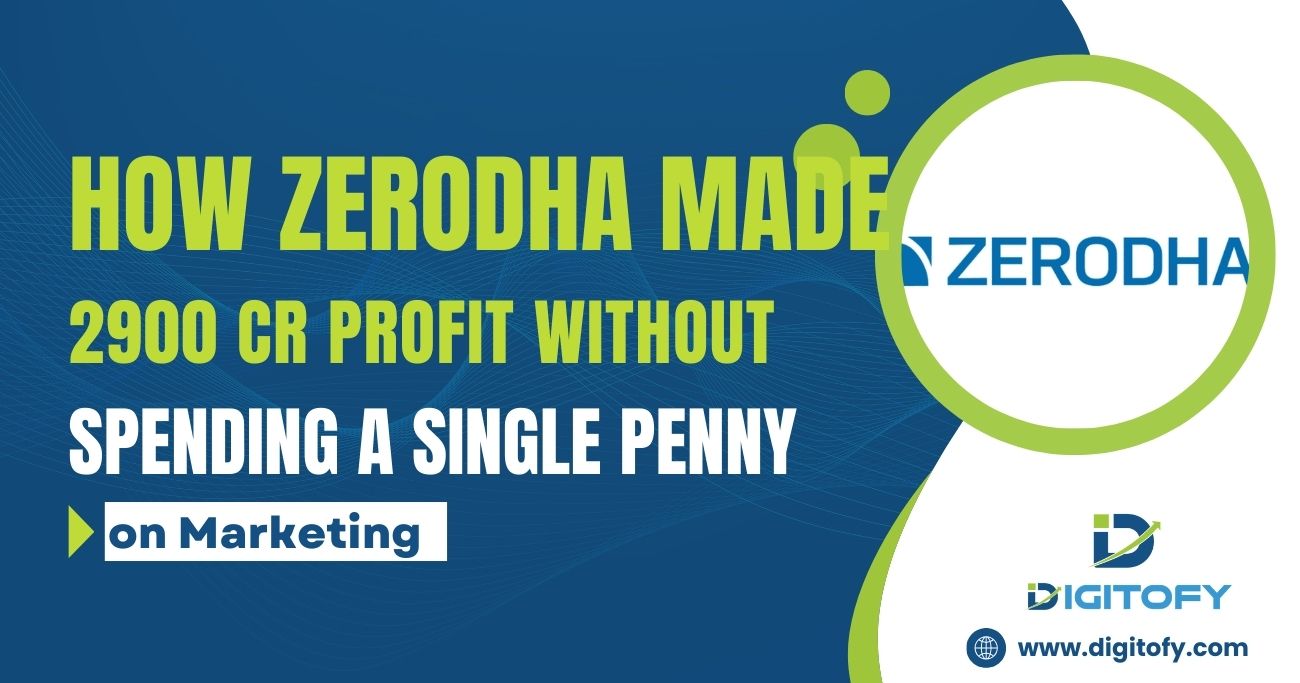How Zerodha Conquered Indian Stock Trading
The Indian financial services industry has long been dominated by legacy institutions that have focused more on profits than empowering retail investors. But in the last decade, an upstart brokerage firm called Zerodha has disrupted the status quo and captured the imagination of a new generation of traders.
Founded in 2010 by brothers Nithin and Nikhil Kamath, Zerodha has grown rapidly to become India’s largest stock brokerage with over 6 million clients. The company’s spectacular rise is a testament to its innovative business model and savvy use of technology to reduce costs and simplify investing for the masses.
About Zerodha
Zerodha Broking Ltd. is an Indian financial services company that provides retail and institutional broking, currencies, and commodities trading, mutual funds, and bonds. Headquartered in Bangalore, the company was founded in 2010 by brothers Nithin and Nikhil Kamath.
Zerodha has disrupted the stock broking industry by pioneering a discount broking model and leveraging technology to offer a robust trading infrastructure at low costs. The company charges zero brokerage on intraday equity trades and ₹20 per executed order for other segments. This competitive pricing helped it acquire customers rapidly in a market dominated by brokers charging higher commissions.
As of January 2023, Zerodha had over 6 million active clients contributing to over 15% of national trading volumes. It reached ₹1000 crore in revenue in FY 2019-20, becoming the largest stock broker in India in terms of active retail clients, orders placed, and turnover. Zerodha has leapfrogged older incumbents like ICICI Securities, HDFC Securities, and Sharekhan with its customer-focused approach.
What’s New with Zerodha?
Despite being the market leader, Zerodha continues to innovate with new offerings and improvements to provide customers with a seamless investing experience.
In 2022, Zerodha launched the Z-Connect app allowing investors to track portfolios, discover ideas, and connect with experts. It aims to be an investing super app offering research, analysis, advice, and community engagement.
Zerodha’s Kite platform also introduced auto rebalancing of multi-asset portfolios. Investors can now set target asset allocations, and Kite will automatically rebalance holdings periodically. This automates portfolio maintenance and helps manage risks.
The launch of Kite Social allows investors to share trades publicly and engage with the community. Traders can follow others, see portfolios and performance, chat, and exchange ideas – making investing more transparent.
For DIY investors, Zerodha has added over 50 hours of free online education courses and videos on trading fundamentals. Topics covered include technical analysis, futures & options, risk management, trading psychology, and more.
Such continual enhancements and new offerings help Zerodha retain its innovative edge. The firm understands the needs of digital-native investors and caters to them through constant technology upgrades and value-added services around investing.
Buyer Personas
Zerodha has two key buyer personas that form its core target audience:
Millennial Investors
The typical Zerodha customer is tech-savvy, informed, seeks value, and wants a simplified investing experience. This persona comprises urban millennials aged between 25 and 35 years who are investing for the first time.
They are digital natives, comfortable transacting via mobiles, and skeptical of established incumbents. They demand convenience, speed, and ease of use.
Millennials prefer DIY investing without dependence on brokers. They expect platforms that are intuitive and tools that provide analytics, charting, and research.
Price sensitivity is high, and this segment wants low brokerage and zero account opening or maintenance charges. They have modest capital but the willingness to take risks and try new investment products.
Experienced Traders
The second key persona is experienced traders and investors looking for advanced tools and an efficient platform.
They are between 30-50 years old, with experience of 5-10 years in trading equities, options, or commodities. Trading is a serious hobby or even a full-time profession for them.
Such users want reliable order execution, real-time margin tracking, and leveraged products like futures & options. Charting, technical indicators, and risk management tools are a must.
Platform stability, order speed, and pricing are critical factors. This persona will switch brokers easily for better features or pricing. Zerodha attracts them with its robust, low-cost trading infrastructure.
Zerodha’s Marketing Mix
Zerodha’s marketing strategy focuses on four key elements – product, pricing, place, and promotion. Let’s examine how the company has leveraged these marketing mix components to acquire and retain customers at scale.
Product Strategy
Zerodha aims to provide customers with a full-service investing platform with powerful trading tools, research capabilities, and a modern user experience.
Its core product Kite offers a clean, intuitive interface with advanced charting and analytics. Customers can trade equities, futures, options, currencies, commodities, and more from a single platform.
For beginners, Varsity provides free investing education through courses, videos, and content. Kite also has DIY tools for fundamental analysis, news, screeners, and risk management.
The ecosystem expands with support services like digitized account opening, dedicated relationship management, and 24/7 customer support.
This end-to-end product experience targeted at millennials and designed for simplicity and transparency sets Zerodha apart from incumbents.
Pricing Strategy
A disruptive, low-cost pricing model is central to Zerodha’s positioning. The company has leveraged technology to reduce operational costs and passed on the benefits to customers.
Zerodha charges zero brokerage for delivery-based equity investing and intraday trading. For futures & options, it charges a flat fee of ₹20 per executed order – one of the lowest in the industry.
There are no account opening or maintenance charges. Demat accounts and additional services like research are also free. This straightforward, affordable pricing helped Zerodha acquire price-sensitive millennial investors rapidly.
By increasing volume, Zerodha offsets the low commissions through scale – the typically low-margin, high-volume model. Higher trading activity by clients allows it to earn revenues despite low brokerage.
Place Strategy
As a digital brokerage, Zerodha serves customers primarily through its online platform and mobile apps. Users can open accounts, fund them, and start trading quickly in a paperless manner.
For customer support, Zerodha offers live chat, email, and call support in addition to an online knowledge base and tutorials. Support is available on trading days for 12 hours.
The company does not have traditional physical branches. However, it provides offline customer interaction through annual events like Investor Hour across major cities. Partnerships with fintech platforms also help with customer acquisition.
By avoiding expensive branch networks, Zerodha keeps costs low. The lean digital-only model aligned with millennials’ preference for transacting online gives it an edge over traditional brokers.
Promotion Strategy
Given its targeted customer base, Zerodha relies heavily on digital marketing across social media, advertising, and content marketing.
Facebook and Instagram ads help attract new users by highlighting Zerodha’s competitive pricing and ease of account opening. The ads focus on the core benefits of the platform.
Educational content like Varsity courses, blogs, and videos aim to build brand awareness and trust. Zerodha establishes thought leadership by regularly publishing market commentary, analysis, and insights as well.
Push notifications, emails, and in-app messaging maintain ongoing user engagement. Referral incentives also encourage existing clients to recommend Zerodha to friends.
The company avoids expensive traditional advertising like print, TV, and outdoors. Digital channels provide higher ROI for acquiring tech-savvy millennials and work well with Zerodha’s lean cost structure.
Zerodha Competitor Analysis
Though the first mover in Indian discount broking, Zerodha now faces competition from both traditional and new-age players. Let’s examine some of its major competitors:
Upstox
Founded in 2012, Upstox positions itself as a technology-driven, low-cost option for online investing. Like Zerodha, it charges zero brokerage on equity delivery and ₹20 per trade for other segments.
Upstox’s platform provides charting, alerts, screening, and research tools under one roof. DIY investors are attracted by its feature-rich, low-cost product.
Backed by marquee investors like Tiger Global, Upstox is reported to have over 3 million customers. Its strong technology platform and funding make it a formidable rival to Zerodha.
Groww
Groww is a Bangalore-based investment platform founded in 2016 that offers direct mutual funds, stocks, and ETFs. It has raised $300 million in funding from investors like Sequoia, YC, and Tiger Global.
Groww allows paperless account opening via apps and focuses on simplifying investing for millennials. It has a slick interface with inbuilt research and analytics.
With a reported user base of over 2 crores, Groww is expanding beyond MFs into equities and emerging as a key competitor, especially in tier 2/3 cities.
Angel One
Angel One is the new-age digital arm of Angel Broking, one of India’s largest retail brokers. Angel One offers a modern platform and flat ₹20 pricing like Zerodha.
It is leveraging its parent’s decades of broking experience and strong brand equity. Angel One provides full-service investing across equities, derivatives, currencies, commodities, and insurance.
Well-capitalized and listed, Angel One can leverage its established ecosystem and distribution network to compete aggressively with fintech disruptors like Zerodha.
Zerodha’s Marketing Tactics for Success
Despite intense competition, Zerodha has managed to maintain its leadership in India’s online broking market through smart marketing strategies across business model innovation, product experience, and brand building.
Business Model Innovation
Zerodha pioneered discount broking in India at scale by leveraging technology to reduce costs and pass on savings to customers through zero-commission trades and low flat fees. This made equities trading affordable for millennials and new investors.
Instead of legacy systems, Zerodha built robust proprietary platforms like Kite from scratch optimized for modern markets. Its tech DNA gives it an advantage in rolling out new features and improvements faster.
The digital-only model avoids expensive physical footprints. Paperless account opening has lowered customer acquisition costs allowing rapid scale-up. Partnerships with banks, payment gateways, and digital platforms also help source clients cost-effectively.
Product Experience
Zerodha focuses obsessively on making investing seamless for digital natives through its platforms. Intuitive user experience, slick design, and simplicity of use attract millennials.
Features like one-click account opening, direct UPI integration, quick order placement, and tracking portfolio performance create a frictionless customer journey. Charting, analytics, and research capabilities cater to experienced traders as well.
Frequent enhancements like auto rebalancing, macros, sentiment tools, etc. based on user feedback help retain the existing client base and keep them engaged.
Brand Building
Education-led content and community foster trust and authority positioning. Through Varsity, blogs, and live events, Zerodha establishes thought leadership and spreads awareness about capital markets.
Strong word-of-mouth and referrals from satisfied millennials help acquire a similar audience cost-effectively. Younger traders view Zerodha as an ethical, customer-focused challenger brand versus traditional profit-hungry brokers.
Prudent use of targeted digital marketing across Google, Facebook, and Instagram amplified via PR and partnerships continues growing its brand reach. Zerodha’s story and founder-led narrative also help attract media coverage.
The Road Ahead
Zerodha’s journey so far underscores how an innovative business model and relentless customer focus can disrupt even entrenched financial services. Millennials are the future of investing in India and forward-thinking firms must cater to them.
As long as Zerodha retains its technology edge, customer centricity, and innovative spirit, the company is well-positioned to fend off rivals. The agile wolf from Bangalore has shown incumbent dinosaurs how financial markets can be transformed to serve the needs of digital natives. The next phase of growth for Zerodha and the industry promises to be even more exciting.

.webp)

